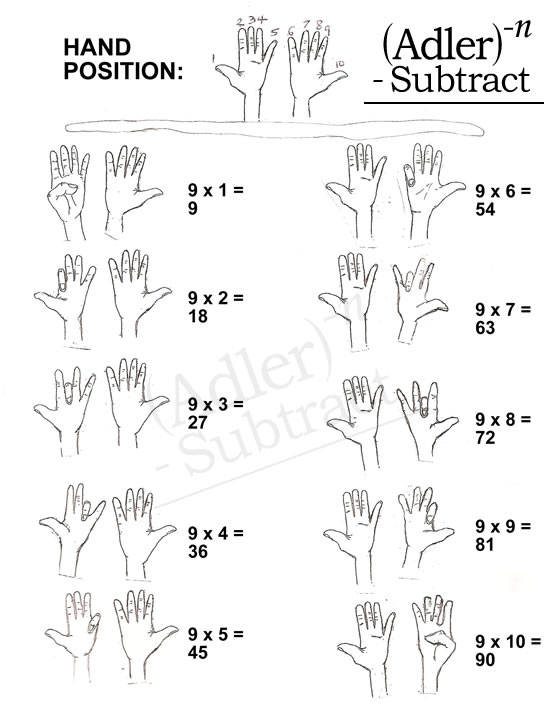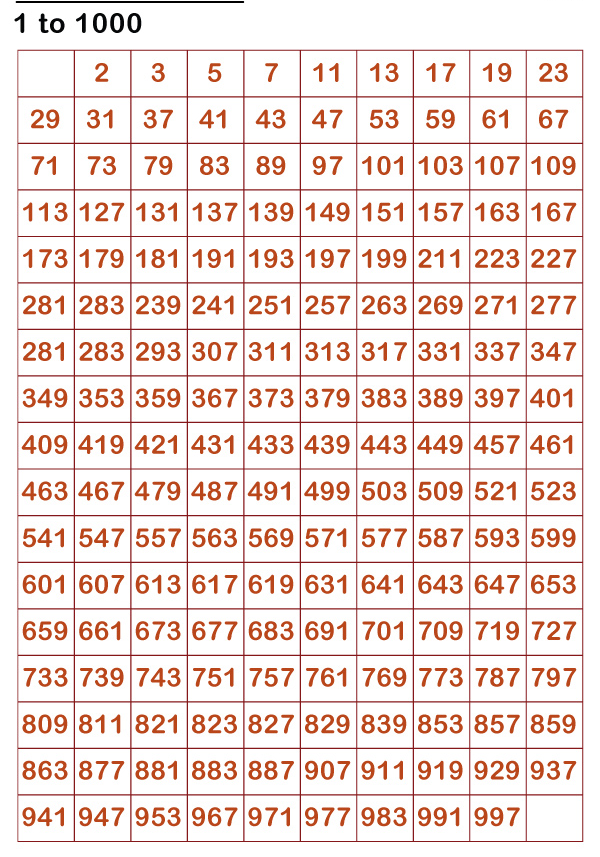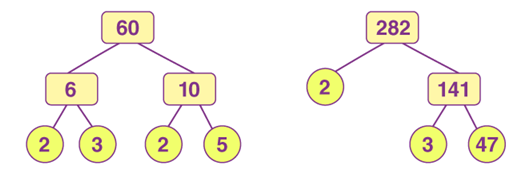Math Magic: Fun Tricks to Amaze and Educate Your Elementary Schooler!
Math doesn't have to be a chore! In fact, it can be downright magical. We're here to share some simple yet impressive math tricks that will not only boost your child's confidence but also make learning numbers a whole lot more fun. Perfect for elementary school kids, these tricks are designed to make math engaging and accessible.
Table of Contents
Multiplication Tricks:
- Multiplication Chart (1-10)
- Multiplication Chart (11-20)
- Multiplication Chart (21-30)
- The "9 Times Table" Finger Trick
- 11's Table Trick
- Prime Factorization
- Positive Divisors Of Large Number
- Probability
- Diagonals In A Polygon
- Divisibility Rules
Math Fun
Settings
"Multiplication Tricks"
Multiplication Chart (1-10)
Times table chart 1 to 10 or the multiplication chart 1 to 10 is the chart that contains tables from 1 to 10 in a tabular format. In the table, the first row contains all the numbers for which we have to write the table i.e. the number from 1, 2, 3, 4, 5, 6, 7, 8, 9, and 10 and the first column contains the numbers for which the multiplication table is found, i.e. 1, 2, 3, 4, 5, 6, 7, 8, 9, and 10. Then each column in the table contains the product of the number from the corresponding first row and first column.
| x | 1 | 2 | 3 | 4 | 5 | 6 | 7 | 8 | 9 | 10 |
| 1 | 1 | 2 | 3 | 4 | 5 | 6 | 7 | 8 | 9 | 10 |
| 2 | 2 | 4 | 6 | 8 | 10 | 12 | 14 | 16 | 18 | 20 |
| 3 | 3 | 6 | 9 | 12 | 15 | 18 | 21 | 24 | 27 | 30 |
| 4 | 4 | 8 | 12 | 16 | 20 | 24 | 28 | 32 | 36 | 40 |
| 5 | 5 | 10 | 15 | 20 | 25 | 30 | 35 | 40 | 45 | 50 |
| 6 | 6 | 12 | 18 | 24 | 30 | 36 | 42 | 48 | 54 | 60 |
| 7 | 7 | 14 | 21 | 28 | 35 | 42 | 49 | 56 | 63 | 70 |
| 8 | 8 | 16 | 24 | 32 | 40 | 48 | 56 | 64 | 72 | 80 |
| 9 | 9 | 18 | 27 | 36 | 45 | 54 | 63 | 72 | 81 | 90 |
| 10 | 10 | 20 | 30 | 40 | 50 | 60 | 70 | 80 | 90 | 100 |
Multiplication Chart (11-20)
Times table chart 11 to 20 or the multiplication chart 11 to 20 is the chart that contains tables from 11 to 20 in a tabular format. In the table, the first row contains all the numbers for which we have to write the table i.e. the number from 11, 12, 13, 14, 15, 16, 17, 18, 19, and 20 and the first column contains the numbers for which the multiplication table is found, i.e. 1, 2, 3, 4, 5, 6, 7, 8, 9, and 10. Then each column in the table contains the product of the number from the corresponding first row and first column.
| x | 11 | 12 | 13 | 14 | 15 | 16 | 17 | 18 | 19 | 20 |
| 1 | 11 | 12 | 13 | 14 | 15 | 16 | 17 | 18 | 19 | 20 |
| 2 | 22 | 24 | 26 | 28 | 30 | 32 | 34 | 36 | 38 | 40 |
| 3 | 33 | 36 | 39 | 42 | 45 | 48 | 51 | 54 | 57 | 60 |
| 4 | 44 | 48 | 52 | 56 | 60 | 64 | 68 | 72 | 76 | 80 |
| 5 | 55 | 60 | 65 | 70 | 75 | 80 | 85 | 90 | 95 | 100 |
| 6 | 66 | 72 | 78 | 84 | 90 | 96 | 102 | 108 | 114 | 120 |
| 7 | 77 | 84 | 91 | 98 | 105 | 112 | 119 | 126 | 133 | 140 |
| 8 | 88 | 96 | 104 | 112 | 120 | 128 | 136 | 144 | 152 | 160 |
| 9 | 99 | 108 | 117 | 126 | 135 | 144 | 153 | 162 | 171 | 180 |
| 10 | 110 | 120 | 130 | 140 | 150 | 160 | 170 | 180 | 190 | 200 |
Multiplication Chart (21-30)
Times table chart 21 to 30 or the multiplication chart 21 to 30 is the chart that contains tables from 21 to 30 in a tabular format. In the table, the first row contains all the numbers for which we have to write the table i.e. the number from 21, 22, 23, 24, 25, 26, 27, 28, 29, and 30 and the first column contains the numbers for which the multiplication table is found, i.e. 1, 2, 3, 4, 5, 6, 7, 8, 9, and 10. Then each column in the table contains the product of the number from the corresponding first row and first column.
| x | 21 | 22 | 23 | 24 | 25 | 26 | 27 | 28 | 29 | 30 |
| 1 | 21 | 22 | 23 | 24 | 25 | 26 | 27 | 28 | 29 | 30 |
| 2 | 42 | 44 | 46 | 48 | 50 | 52 | 54 | 56 | 58 | 60 |
| 3 | 63 | 66 | 69 | 72 | 75 | 78 | 81 | 84 | 87 | 90 |
| 4 | 84 | 88 | 92 | 96 | 100 | 104 | 108 | 112 | 116 | 120 |
| 5 | 105 | 110 | 115 | 120 | 125 | 130 | 135 | 140 | 145 | 150 |
| 6 | 126 | 132 | 138 | 144 | 150 | 156 | 162 | 168 | 174 | 180 |
| 7 | 147 | 154 | 161 | 168 | 175 | 182 | 189 | 196 | 203 | 210 |
| 8 | 168 | 176 | 184 | 192 | 200 | 208 | 216 | 224 | 232 | 240 |
| 9 | 189 | 198 | 207 | 216 | 225 | 234 | 243 | 252 | 261 | 270 |
| 10 | 210 | 220 | 230 | 240 | 250 | 260 | 270 | 280 | 290 | 300 |
Memorize the 9 Tables
This classic trick is a fantastic way to master the 9 times table without memorizing every single fact.
 How it works:
How it works:
- Hold both hands out in front of you, palms facing away.
- To multiply 9 by a number (let's say 9 x 3), count from the left, and fold down the third finger.
- The fingers to the left of the folded finger represent the tens (in this case, 2).
- The fingers to the right represent the ones (in this case, 7).
- So, 9 x 3 = 27.
- This works for 9 multiplied by any number from 1 to 10.
11's Table Trick
This is a quick way to multiply two-digit numbers by 11 in your head.
- Separate the two digits in your mind.
- Add the two digits together.
- Place the number from Step 2 between the two digits. If the number from Step 2 is greater than 9, put the one's digit in the space and carry the ten's digit.
Examples: 72 × 11 = 792
57 × 11 = 5_7, but 5 + 7 = 12, so put 2 in the space and add the 1 to the 5 to get 627.
Prime Numbers

A prime number (or a prime) is a natural number greater than 1 that is not a product of two smaller natural numbers. A natural number greater than 1 that is not prime is called a composite number. For example, 5 is prime because the only ways of writing it as a product, 1 × 5 or 5 × 1, involve 5 itself. However, 4 is composite because it is a product (2 × 2) in which both numbers are smaller than 4. Primes are central in number theory because of the fundamental theorem of arithmetic: every natural number greater than 1 is either a prime itself or can be factorized as a product of primes that is unique up to their order.
Finding Prime Numbers Using Factorization Factorisation is the best way to find prime numbers. The steps involved in using the factorisation method are:
- Step 1: First find the factors of the given number.
- Step 2: Check the number of factors of that number.
- Step 3: If the number of factors is more than two, it is not a prime number.
Here are some tips to quickly remember prime numbers (say 1-100):
- Write all numbers from 1 to 100 in rows of 6.
- Cross out multiples of numbers up to 10.
- Remember that 2 is the only even prime number.
- Prime numbers usually end in 1, 3, 7, or 9.
- Add the digits of a number; if the sum is divisible by 3, it's not prime.
| x | - | - | - | - | - | - | - | - | - | - | 25 |
| 1-10 | 1 | 2 | 3 | 4 | 5 | 6 | 7 | 8 | 9 | 10 | 4 |
| 11-20 | 11 | 12 | 13 | 14 | 15 | 16 | 17 | 18 | 19 | 20 | 4 |
| 21-30 | 21 | 22 | 23 | 24 | 25 | 26 | 27 | 28 | 29 | 30 | 2 |
| 31-40 | 31 | 32 | 33 | 34 | 35 | 36 | 37 | 38 | 39 | 40 | 2 |
| 41-50 | 41 | 42 | 43 | 44 | 45 | 46 | 47 | 48 | 49 | 50 | 3 |
| 51-60 | 51 | 52 | 53 | 54 | 55 | 56 | 57 | 58 | 59 | 60 | 2 |
| 61-70 | 61 | 62 | 63 | 64 | 65 | 66 | 67 | 68 | 69 | 70 | 2 |
| 71-80 | 71 | 72 | 73 | 74 | 75 | 76 | 77 | 78 | 79 | 80 | 3 |
| 61-90 | 81 | 82 | 83 | 84 | 85 | 86 | 87 | 88 | 89 | 90 | 2 |
| 91-100 | 91 | 92 | 93 | 94 | 95 | 96 | 97 | 98 | 99 | 100 | 1 |
Prime Factorization

In the figure, we can show how number 60 is first factorized into two numbers i.e. 6 and 10.
- Again, 6 and 10 is factorized to get the prime factors of 6 and 10, such that;
- 6 = 2 × 3
- and 10 = 2 × 5
- If we write the prime factors of 60 altogether, then;
- Prime factorization of 60 = 6 × 10 = 2 × 3 × 2 × 5
- Same is the case for number 282, such as;
- 282 = 2 × 141 = 2 × 3 × 47
A common trick for prime factorization, especially when dealing with larger numbers, is to start by trying the smallest prime numbers (2, 3, 5, 7, 11, etc.) as divisors. This method, known as trial division, can quickly identify prime factors if the number is divisible by them. Another helpful tip is to use divisibility rules for the smaller primes, which can speed up the process of finding divisors.
Here's a breakdown of the process:
- Start with the smallest prime:
Begin by checking if the number is divisible by 2 (even numbers), then 3 (if the sum of digits is divisible by 3), and so on. - Use divisibility rules:
Divisibility rules for 2, 3, 5, 11, and others can help you quickly determine if a number is divisible by those primes. - Continue with larger primes:
Once you've checked the smaller primes and found a factor, divide the number by that factor and repeat the process with the new quotient. - Stop when you reach prime factors:
Continue dividing by prime numbers until you are left with only prime factors. - Combine the prime factors:
The prime factorization is the product of all the prime factors you found.
Example:
- Let's say you want to find the prime factorization of 72.
- 72 is even, so it's divisible by 2: 72 ÷ 2 = 36.
- 36 is also even, so it's divisible by 2: 36 ÷ 2 = 18.
- 18 is even, so it's divisible by 2: 18 ÷ 2 = 9.
- 9 is divisible by 3: 9 ÷ 3 = 3.
- 3 is a prime number.
- Therefore, the prime factorization of 72 is 2 × 2 × 2 × 3 × 3, or 23 x 32.
To find the prime factorization of the given number using factor tree method, follow the below steps:
- Step 1: Consider the given number as the root of the tree
- Step 2: Write down the pair of factors as the branches of a tree
- Step 3: Again factorize the composite factors, and write down the factors pairs as the branches
- Step 4: Repeat the step, until to find the prime factors of all the composite factors
Positive Divisor Of Large Number
Let us learn this trick of how to find quickly all positive divisors of a large number. As an example let us find all positive divisors of 1980.
To find the number of divisors of a number, we can prime factorize the number and use the formula (a1+1),(a2+1)...(ak+1), where (a1,a2,... ,ak) are the exponents in the prime factorization.
How to solve?
To prime factorize 1980 we use the formula mentioned above..
Step 1: Prime factorize 1980
- 1980 = 2 × 990
- 990 = 2 × 495
- 495 = 5 × 99
- 99 = 9 × 11
- 9 = 3 × 3
- So 1980 = 2 × 2 × 3 × 3 × 5 × 11 = 22×32×51×111.
Step 2: Use the formula above to find the number of divisors
- The exponents are 2, 2, 1 and 1
- Thus the number of divisors are (2 + 1) × (2 + 1) × (1 + 1) × (1 + 1)
- (3)×(3)×(2)×(2) = 36
The number of positive divisors of 1980 are 36
Hence, the factors of 1980 are 1, 2, 3, 4, 5, 6, 9, 10, 11, 12, 15, 18, 20, 22, 30, 33, 36, 44, 45, 55, 60, 66, 90, 99, 110, 132, 165, 180, 198, 220, 330, 396, 495, 660, 990, 1980.
Probability
Many events can't be predicted with total certainty. The best we can say is how likely they are to happen, using the idea of probability.

When a coin is tossed, there are two possible outcomes: Heads (H) or Tails (T)

When a single die is thrown, there are six possible outcomes: 1, 2, 3, 4, 5, 6
Probability Question
John rolls 3 standard 6 sided dice 2 red and 1 yellow what is the probability that the numbers rolled on the red dices are both greater than the number rolled on the yellow die?
Let's calculate this step by step:
- Understand the dice rolls: Each die has 6 faces (numbers 1 through 6). John rolls two red dice and one yellow die.
- Key condition: Both numbers rolled on the red dice must be greater than the number rolled on the yellow die.
- Total outcomes: Since each die roll is independent, there are a total of 6 × 6 × 6 = 216 possible outcomes.
- Counting favorable outcomes:
- Let the number rolled on the yellow die be 𝑌, and the numbers on the red dice be 𝑅1 and 𝑅2.
- To satisfy the condition 𝑅1 > 𝑌 and 𝑅2 > 𝑌, we need to count how many values 𝑅1 and 𝑅2 can take for each possible 𝑌.
- Let's find all possible outcomes,
- If 𝑌 = 1: Both 𝑅1 and 𝑅2 can be any of 2,3,4,5,6. That’s 5 × 5 = 25 outcomes.
- If 𝑌 = 2: 𝑅1 and 𝑅2 can be any of 3,4,5,6. That’s 4 × 4 = 16 outcomes.
- If 𝑌 = 3: 𝑅1 and 𝑅2 can be any of 4,5,6. That’s 3 × 3 = 9 outcomes.
- If 𝑌 = 4: 𝑅1 and 𝑅2 can be any of 5,6. That’s 2 × 2 = 4 outcomes.
- If 𝑌 = 5: 𝑅1 and 𝑅2 can only be 6. That’s 1 × 1 = 1 outcome.
- If 𝑌 = 6: 𝑅1 and 𝑅2 can't be greater than 𝑌. So 0 outcomes.
- Sum of favorable outcomes: 25 + 16 + 9 + 4 + 1 = 55
- Probability: The probability is the ratio of favorable outcomes to total outcomes:
Probability = =
Final Answers
The probability is , which is approximately 0.2546 or 25.46%.
Diagonals In A Polygon
A polygon with n sides has diagonals. This formula can be derived by considering that each vertex can connect to n-3 other vertices to form a diagonal, and then accounting for the fact that each diagonal is counted twice (once for each endpoint).
Explanation:
Divisibility Rules
Division is a mathematical operation used to distribute a quantity into equal parts or to find out how many times one number (the divisor) is contained within another number (the dividend). The result of division is called the quotient.

The formula for division is: Quotient =
Easy Division Tricks
Here are easy division tricks to fasten your calculation:
| Divisible By | Conditions | Examples |
|---|---|---|
| 2 | Last digit is 0,2,4,6,8 | 132, 100, 12 |
| 3 | Sum of the digits is divisible by 3 | 4764; 4+7+6+4 = 21 21⁄3 = 7 |
| 4 | Last 2 digits are divisible by 4 | 1924 24⁄4 = 6 |
| 5 | Last digit is 0 or 5 | 255, 1970 |
| 6 | Number is divisible by both 2 and 3 | 7782; 7+7+8+2 = 24 24⁄3 = 8 |
| 7 | Double the unit digit and subtract it from the rest of the number. The reusltign number must be divisible by 7. | 385; 38 − (2 × 5) = 28 28⁄7 = 4 |
| 8 | A number is divisible by 8 if the number formed by its last three digits is divisible by 8 | 1320 320⁄8 = 40 |
| 9 | Sum of all its digits is divisible by 9 | 288; 2+8+8 = 18 18⁄9 = 2 |
| 10 | Last digit is 0 | 8070 |
Math Fun
Multiply By 6
Multiples of 6 If you multiply 6 by an even number, the answer will end with the same digit. The number in the ten's place will be half of the number in the one's place.
Example: 6 × 4 = 24
Same Three-Digit Number
This trick works everytime because the sum of the digits will always be 3 times the digit, and each three-digit number is a multiple of that digit and 111. Thus, in the last step, you're effectively canceling out the digit in the division and left with 111 divided by 3, which is 37.
- Think of any three-digit number in which each of the digits is the same. Examples include 333, 666, 777, and 999.
- Add up the digits.
- Divide the three-digit number by the answer in Step 2
The answer is 37.
